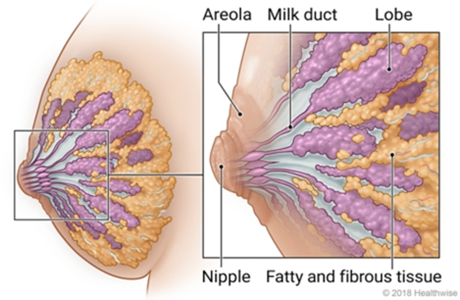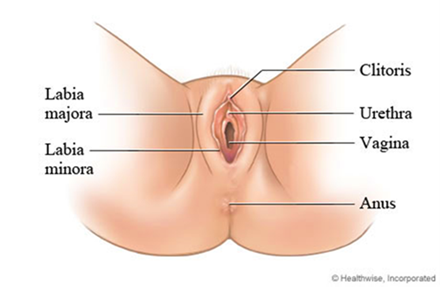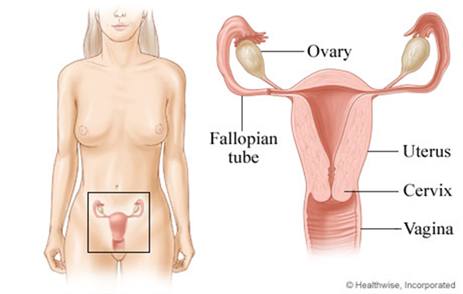This information will help you understand the female reproductive system (before treatment) and some of the words your doctor or healthcare provider might use.
The reproductive system is made up of the breasts, the external genitals, and the internal genitals.
The Breasts
A breast is made up of several parts.

- Inside the breast are
glands,
ducts, and
fatty tissue. When a woman is pregnant or has had a baby, the glands contain milk to feed the baby.
- On the outside of the breast is the areola, which is a round, darker spot of skin. It can be dark brown, red, or pink. There are little bumps on the surface of the areola.
- The
nipple sticks out from the center of the
areola. It’s made up of many tiny openings.
The breasts are full of nerve endings—especially the nipple. When it’s touched in a sexual way, it can feel good and make you feel turned on (sexually aroused).
External genitals (genitals on the outside)

Together, the external genitals are called the vulva. The size and shape of everyone’s genitals is different. Some parts of the genitals have lots of nerve endings. When touched for pleasure, blood flow to the area increases and this can lead to feeling aroused. The external genitals include: 
- The
mons pubis is a rounded mass of tissue over the pubic bone. It's covered by skin and pubic hair.
- The
labia majora (outer lips) are the 2 large folds of skin that normally come together in the middle. This protects the openings to the vagina and the urethra (part of the urinary system). Hair grows on the outside of the labia majora, but the inner surfaces are smooth.
- The
labia minora (inner lips) are the 2 inner folds of skin. They have many nerves and blood vessels, which get bigger and spread apart when you are aroused.
- The
vestibule is the area of the vulva where the openings to the vagina and urinary system are. The opening of the vagina may be partly covered by a thin membrane called the hymen. The hymen protects the vagina from infection before puberty.
- The
clitoris is the most sensitive part of the genitals. It’s at the top of the vulva, just under where the top of the inner lips meet. It looks like a tiny pea and may be covered by skin called the clitoral hood. The clitoris has lots of nerve endings and is made up of tissue that fills with blood when you get aroused. The clitoris often needs to be stimulated to reach orgasm.
- The
perineum is the skin between the bottom of the labia and the anus (the opening to the rectum). The perineum and the anus have lots of nerve endings.
Internal genitals (genitals on the inside)


Vagina
The
vagina starts at the opening (called the
vestibule) and goes to the bottom of the
uterus. The opening of the uterus is called the
cervix.
- When you are aroused, the vagina gets longer and wider. The vagina can change size to fit closely around a tampon, a finger, a sexual toy, a penis during intercourse, or a baby during childbirth. When not aroused, the walls of the vagina collapse.
- The pelvic floor muscles support but aren’t part of the vagina. These muscles contract when you are aroused or having an orgasm.
- The inside of the vagina is like the inside of the mouth. Glands inside the vagina make drops of lubricating fluid to keep it moist. When you are aroused, more of this fluid is made.
- The bottom part of the vagina has more nerves than the top part and is very sensitive. The top of the vagina has only a few nerves and isn’t as sensitive.
- Some researchers say there is an area that’s very sensitive on the front, lower part of the vagina called the G-spot. During intercourse or penetration (like with a finger, sexual toy, or object), this bottom part of the vagina is very sensitive to pressure and touch
Uterus
The
uterus is at the top of the vagina, above the cervix. When not pregnant, your uterus is about the same size as a closed fist. The uterus has 3 layers:
- outer layer, which is elastic and stretches during pregnancy
- middle layer, which is muscle (this layer makes contractions during childbirth and contracts during an orgasm for some people)
-
inner layer, which builds up each month with blood and tissue (this tissue sheds each month during your period)
Fallopian tubes, ovaries, and hormones
The top of the uterus opens into 2
fallopian tubes.
At the other end of each tube is an
ovary. The ovary produces and stores eggs. After reaching puberty, 1 egg is usually released during each menstrual cycle. The egg travels down the fallopian tube and may be fertilized as it travels to the uterus. A fertilized egg will attach to the inner layer of the uterus. Unfertilized eggs break down and are shed away with the lining of the uterus each month during your period. The ovaries make 2 hormones: estrogen and progesterone.
Estrogen helps keep the vagina moist and stretchy. Most experts agree that the hormone estrogen doesn’t control sex drive. If the ovaries are removed, it isn’t likely to affect sex drive or the ability to have an orgasm.
The hormone that affects sex drive is called testosterone. Testosterone is made by the testicles, ovaries, and adrenal glands, which are above the kidneys.
Hormones are controlled by the brain. During menopause, estrogen decreases, which may make the vagina and vulva less healthy and less moist. You may get
vaginal discomfort and dryness. You can manage this dryness and discomfort with
topical hormonal replacement (using estrogen) or with non-hormonal vaginal moisturizers. You can also use
lubricants to increase vaginal moisture during sexual intercourse.
